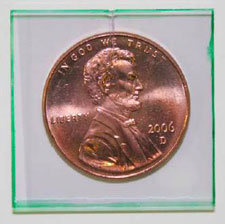30 October 2006
 The transparent film over the penny in the image has 70 transistors on it. They are made of invisible materials recently developed at Northwestern University. (Credit: Lian Wang and Myung-Han Yoon, Northwestern University)
The transparent film over the penny in the image has 70 transistors on it. They are made of invisible materials recently developed at Northwestern University. (Credit: Lian Wang and Myung-Han Yoon, Northwestern University)By developing a low-cost method for making high-performance transparent transistors, the research group led by Prof. Tobin Marks of chemistry and materials-science at Northwestern University has taken an important step toward creating sharp, bright displays that could be laminated to windshields, computer monitors, and televisions but would blend into the background when not in use.
Most of the transistor is composed of indium oxide, an inorganic semiconductor that can be produced at low cost because it can be deposited over large areas at room temperature. The process Marks employs to make them is a standard technique that uses ion beams to control the crystallization and adhesion of the oxide as it is deposited onto a surface. The method can also be used to adjust the conductivity of the final material, which makes it possible to use indium oxide as a semiconductor in one part of the device and as a conductor in other parts.
The technical details will appear in the journal Nature Materials. Read more here.
(via Technology Review)
0 Comments:
All Topics



